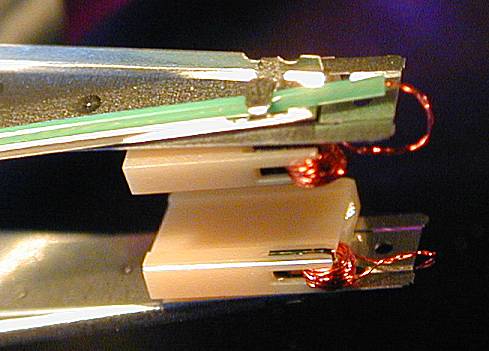[ The PC Guide | Systems and Components Reference Guide | Hard Disk Drives | Construction and Operation of the Hard Disk | Hard Disk Read/Write Heads | Hard Disk Read/Write Head Technologies ]
Thin Film (TF) Heads
Thin Film (TF) heads--also called thin film inductive (TFI)--are a totally different design from ferrite or MIG heads. They are so named because of how they are manufactured. TF heads are made using a photolithographic process similar to how processors are made. This is the same technique used to make modern thin film platter media, which bears the same name; see here for more details on this technology.
In this design, developed during the 1960s but not deployed until 1979, the iron core of earlier heads, large, bulky and imprecise, is done away entirely. A substrate wafer is coated with a very thin layer of alloy material in specific patterns. This produces a very small, precise head whose characteristics can be carefully controlled, and allows the bulky ferrite head design to be completely eliminated. Thin film heads are capable of being used on much higher-density drives and with much smaller floating heights than the older technologies. They were used in many PC hard disk drives in the late 1980s to mid 1990s, usually in the 100 to 1000 MB capacity range.
|
A pair of mated thin film head assemblies, greatly
magnified. The heads are |
As hard disk areal densities increased, however, thin film heads soon reached their design limits. They were eventually replaced by magnetoresistive (MR) heads.
![]() Next: (Anisotropic) Magnetoresistive (MR/AMR) Heads
Next: (Anisotropic) Magnetoresistive (MR/AMR) Heads
| The PC Guide
(http://www.PCGuide.com) Site Version: 2.2.0 - Version Date: April 17, 2001 © Copyright 1997-2004 Charles M. Kozierok. All Rights Reserved. |
Not responsible for any loss resulting from the use of this site. Please read the Site Guide before using this material. |
